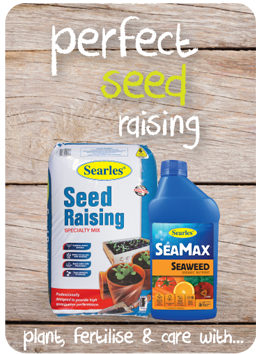|
There are two main methods of sowing seeds to produce wonderful crops of vegetables, herbs and brilliant displays of stunning flowers. These two methods are direct sowing, or sowing into germination trays for transplanting later.
DIRECT SEED SOWING METHOD
There are only a handful of plants that will respond well to direct sowing. The majority of seeds will germinate best when sown in seedling containers/germination trays, and maintained in this controlled environment until they have established themselves, before being transplanted into their desired position in the garden.
Seeds that are commonly used for direct sowing include the following: bean, beetroot, carrot, Chinese cabbage, corn, cucumber, honeydew melon, kohlrabi, parsnip, pea, potato, pumpkin, radish, rockmelon, spinach, squash and watermelon. These are just a few varieties of the many vegetable, herb and flower seeds available from your local garden centre.
Following are some simple steps to successful direct sowing:
HOW TO DIRECT SOW
For sowing seeds directly, here are a few pointers, which will help produce great germination results and give your young plants a racing start for a healthy and productive life.
- Prepare the soil in advance with 5 IN 1 or Searles Premium Compost Mix. Dig these into the top 10cm (4 inches) of your soil and rake the surface to produce a fine tilth. Water soil prior to planting. As a general rule, most leaf, fruiting and flowering plants need copious quantities of organic fertiliser and compost to produce good results. On the other hand, root crops such as carrot, parsnip and radish do not like too much manure; therefore they require less organic fertiliser.
- Follow the directions on the seed packets for planting depth, plant spacing and distance between rows.
- Cover the seeds with a light dressing of Searles Seed Raising Mix and water well with a fine spray, being sure to soak the soil to moisten the seeds, to initiate the germination process.
- Apply a dilute application of SeaMax Seaweed at the rate of 200 parts water to one part liquid seaweed (50ml liquid seaweed in a 10 litre bucket of water). Liquid seaweed has the wonderful effect of promoting strong root growth and aiding in healthy plant establishment.
- Keep the soil moist until germination and water the young plants as required. A helpful old technique commonly used to assist seed germination was to cover the seedling bed with a layer of hessian and keep this moist. Once the seed germinated and the new growth emerged from the soil, then the hessian was removed.
SEED SOWING IN GERMINATION TRAYS/CONTAINERS
There are some distinct advantages to sowing seeds in germination trays.
Firstly, the environment for seed germination is much easier to control and certainly simpler to maintain. It is far easier to care for and give extra attention to many tiny seedlings in a small place such as a germination tray compared to a wide area of garden bed. During the critical early period of growth, when ideal conditions can make such a difference, this can easily be accomplished with far less time and effort.
Using a germination tray, the young seedlings can be grown to an age that they can be transplanted into the garden bed with much greater ease and a better chance of success. This will also help to overcome the problem of weeds overtaking young seedlings in the garden. By planting out seedlings that are already three to four weeks old, these seedlings will already have a head start on any new weeds that may germinate in the garden bed, because the garden soil can be tilled immediately prior to transplanting. However, if you were to plant the seeds directly into the garden, weed seeds may germinate simultaneously and would quickly outgrow the plants you have sown.
Following are some steps to successful seed germination in germination trays:
- Fill the seedling tray or seedling punnet with Searles Seed Raising Mix. For best results, fill at least 1 inch, preferably 2 inches deep.
- Follow the directions on the seed packets for the depth of sowing.
- Now moisten the seed raising mix with a dilute application of SeaMax Seaweed at the rate of 200 parts water to one part liquid seaweed (50ml liquid seaweed to 10 litres water). Do this gently with a fine spray so as not to disturb the tiny seeds and make sure that all the mix has thoroughly been moistened.
- Cover the germination tray with a plastic lid to create its own microclimate. This will enhance seed germination, producing stronger and healthier young seedlings for transplanting later. Keep the container in a shaded area away from direct sunlight. Once the seedlings germinate, the lid can be removed and the seedlings can gradually be introduced to stronger sunlight.
- Be sure to keep the seed raising mix moist continuously until the young seedlings are to be transplanted. However, do not water so much as to waterlog the mixture as this may prevent germination success.
By raising seeds in the controlled climate of a germination tray, the young seedlings have a better chance of establishing themselves and becoming harder and tougher. Once transplanted into the garden, they will flourish and grow with great vigour and probably fewer spaces than you may have from attempting direct sowing. (This does not apply to the seeds that are well suited for direct sowing - see Direct Sowing).
FERTILISING
Once the seeds have germinated and the young seedlings are beginning to produce new leaves, then they will benefit from applications of SeaMax Organic Fertiliser Liquid. Start by applying at a dilute rate of 200 parts water to one part liquid fertiliser (50ml SeaMax Organic Fertiliser in a 10 litre bucket of water). Then as the seedlings grow, increase the strength of fertiliser up to 100ml liquid fertiliser in a 10 litre bucket of water.
Another great fertiliser to use for young seedlings is Searles Flourish Soluble Plant Food. The packet contains directions for seedlings, vegetables and flowers, pot plants, fruit trees and produces wonderful strong growth and is a brilliant bloom booster.
|

---------------------------------
FOR MORE INFO
CLICK PRODUCT NAME BELOW
Seed Raising Mix
SeaMax® Seaweed
Fertiliser
|






